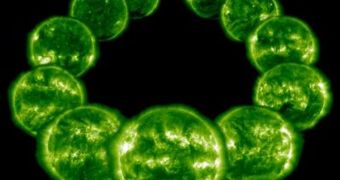It's widely known that the Sun functions on an 11-year cycle, varying periods of intense activity and relative stagnation. The human eye is not attuned to observing the differences – when looking at the noon sky, the star looks the same way it always has. We see visible light fairly proficient, but cannot see the EUV (extreme ultraviolet) wavelengths, on which these variations occur. This is why NASA is currently preparing a new mission to analyze the changes, dubbed the EUV Variability Experiment.
EVE is scheduled to launch later this year, aboard the Solar Dynamics Observatory. “The problem is, human eyes are tuned to the wrong wavelength. If you want to get a good look at solar activity, you need to look in the EUV,” University of Colorado in Boulder (UCB) solar physicist Tom Woods explains the need for the mission.
Far-ultraviolet wavelengths exist between one and 120 nanometers, while the human eye can only detect wavelengths ranging from 380 to 750 nanometers. The EUV has the ability to inflict damage on the human body, because of the high energy its photons have. Luckily for us, the atmosphere protects us from nasty sunburns.
Studying these radiations is therefore very important, especially when taking into account the fact that, within just a few minutes, EUV emissions can increase or decrease by factors of hundreds of thousands. The Earth's upper atmosphere is especially sensitive to these variations. It heats up when more ultraviolet light hits it, and increases its drag on satellites. Additionally, the production of ion layers increases considerably, which can severely distort and disturb radio communications around the globe.
“EVE gives us the highest time resolution and the highest spectral resolution that we've ever had for measuring the sun, and we'll have it 24/7. This is a huge improvement over past missions,” Woods, who is also the lead scientist on the project, says. “Solar minimum is a quiet time when we can establish a baseline for evaluating long-term trends. All stars are variable at some level, and the Sun is no exception. We want to compare the Sun's brightness now to its brightness during previous minimum and ask: is the Sun getting brighter or dimmer?” he adds.
“The EUV portion of the sun's spectrum is what changes most during a solar cycle, and that is the part of the spectrum we will be observing,” the expert says. According to recent studies, it would appear that the star is getting dimmer. Over the past 12 years, the star's “irradiance” has decreased by about 0.02 percent at visible wavelengths and by six percent at EUV wavelengths. However, astronomers are aware that they yet do not have a thorough understanding of the mechanisms that dictate the changes inside the star.

 14 DAY TRIAL //
14 DAY TRIAL //